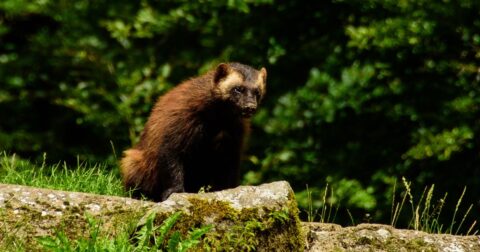News
GLP-1 Users Lose Weight, and Their Taste for Meat
Research•3 min read
Solutions
Veganized scent lures and camera traps are two tools scientists can use to minimize human impact on wildlife.


Words by Carolyn Bernhardt
Here in the United States, wildlife management has long prioritized hunting and ranching on public lands. But Robert Long and his team at Woodland Park Zoo are charting a different course. Leading the charge towards noninvasive research methods, Long, a senior conservation scientist based in Seattle, is transforming the study of elusive carnivores like wolverines in the Cascade Mountains. With a shift toward methods that minimize human impact, Long’s work not only sets a new standard for wildlife observation but is part of a growing trend of change in how researchers look at animals.
“To this day, many of the wildlife management agencies and entities are still aimed at maintaining populations of animals for hunting and fishing and resource use,” Robert Long, a senior conservation scientist in Seattle tells Sentient. Long and his team at the Woodland Park Zoo study wolverines in the Cascade Mountains, and their work is at the forefront of noninvasive wild animal research.
The trend towards noninvasive research methods for studying carnivores kicked off around 2008, Long tells Sentient, around the time he and his colleagues edited a book on noninvasive survey methods. “We didn’t invent the field by any stretch,” he explains, but the publication served as a kind of manual for researching wildlife with as little impact as possible.
For centuries, humans hunted and trapped wolverines, sometimes even poisoning them to protect livestock. By the early part of the 20th century, the decline was so profound that scientists considered them gone from the Rocky and Cascade Mountains.
Around three decades ago however, a few elusive wolverines reappeared, having loped down to the rugged Cascade Mountains from Canada. According to Washington Department of Fish and Wildlife estimates, the population is now hovering at less than 25 wolverines.
The Woodland Park Zoo team uses noninvasive research methods exclusively to observe the threatened population, including trail cameras alongside scent lures, rather than bait stations. Now, they are even developing a new “vegan” scent lure recipe. And the model the team developed for the wolverine population in the Cascades can be replicated elsewhere, even for research on other wildlife species.
Camera traps gather visual data rather than animals, reducing stress on wildlife and lowering costs in the long run. In 2013, Long began collaborating with a Microsoft engineer to devise a winter-resistant scent dispenser that researchers could use instead of bait — roadkill deer and chicken legs — to bring wolverines close to hidden trail cameras for observation. The move from bait to scent lures, Long says, has countless benefits for both animal welfare and research outcomes alike.
When researchers use bait, they have to replace the animal used to attract the research subject on a regular basis. “You would have to go out at least once a month on a snow machine with skis or snowshoes and hike into that station to put a new piece of bait there,” says Long. “Every time you go into a camera or survey site, you’re introducing human scent, you’re introducing disturbance.”
Many carnivorous species, like coyotes, wolves and wolverines, are sensitive to human scent. As Long explains, human visits to a site inevitably dissuade animals from dropping in. “The fewer times we can go into a site, the less human odor, the less human disturbance,” he says, “the more likely we are to get responses from animals.”
Liquid-based scent dispensers also minimize human impact on the ecosystem. When researchers offer up a steady food supply to attract research subjects, the change can inadvertently lead wolverines and other interested carnivores to become habituated to those human-provided food sources.
Using scent dispensers or liquid-based lures also minimizes the risk of disease spread, particularly for the types of species that can spread illnesses like Chronic Wasting Disease. Bait stations provide ample opportunity to spread pathogens — bait can become contaminated with pathogens, animals can transport infected bait and waste that harbors and proliferates diseases can build up and spread throughout the landscape.
And unlike bait that requires replenishing, the durable dispensers can withstand year-round deployment in remote and harsh environments.
Long and the team are now working with a food science lab in California to turn their lure recipe into a new synthetic scent, a vegan replica of the original. While the wolverines don’t care that the recipe is vegan, the synthetic materials help researchers minimize ethical concerns they may have about where they source the scent lure liquid from.
The original version of the liquid was passed down for centuries from fur trappers and made of liquid beaver castoreum oil, pure skunk extract, anise oil and either commercial mustelid lure or fish oil. Sourcing for these ingredients can be a drain on animal populations and other natural resources.
Researchers don’t always know how their ingredients are sourced. “Most trapper supply stores don’t advertise or publicize where they get their [scent ingredients],” Long says. “Whether one is supportive of trapping or not, we always hope that those animals were humanely killed, but that type of information isn’t generally something that’s shared.”
Switching to a predictable, synthetically sourced solution that researchers can easily obtain and reproduce will help researchers eliminate variables that can muddy results and lead to disjointed findings, Long argues. On top of that, using readily-available ingredients also ensures scientists can avoid supply chain issues.
Since 2021, Long and his team have built and made over 700 scent lures at the zoo and sold them to research teams at various organizations across the Intermountain West and Canada. Researchers realized early on that the scent wasn’t just attracting wolverines but many other species, such as bears, wolves, cougars, martens, fishers, coyotes and bobcats. An increased demand for scent lures means an increased demand for animal-sourced lure scents.
“Most biologists are probably not thinking about vegan types of baits, so it’s a pretty leading edge,” says Long, who is clear-eyed about the practicalities. “I’m not under the illusion that most biologists want to go to something vegan just because it’s vegan,” he says. “Many of them are hunters themselves. So it’s an interesting paradigm.”
Long, who is vegetarian, only uses noninvasive research methods. Still, he understands there is disagreement in the field, and arguments for using traditional methods like capture-and-collar and radio telemetry, to study some species that are otherwise challenging to observe. “We all draw our lines in certain places,” he says, but ultimately, the wider move towards noninvasive methods is an improvement for wild animal welfare.
Vegan baits are a cutting-edge idea, but Long says the broader trend towards noninvasive techniques like camera trapping, are on the rise in wildlife research. “We’re developing methods to do noninvasive research more effectively, efficiently and humanely,” Long says. “I think it’s something that, hopefully, everyone can get around no matter where you’re drawing your lines.”
This piece has been updated to correct the population estimates for wolverines in the Cascades.